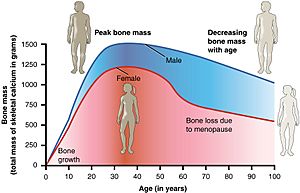Osteoporosis facts for kids
Osteoporosis is a condition where your bones become less dense and weaker over time. This means they have less bone mass and their structure becomes more fragile. Imagine your bones are like a sponge. With osteoporosis, the holes in the sponge get bigger, making it easier to break than a sponge with tiny, tightly packed holes.
Contents
Why Are Strong Bones Important?
Your bones are super important! They support your body, protect your organs, and allow you to move. Bone density is how much mineral is packed into your bones. The more minerals, like calcium, the denser and stronger your bones are. When you have osteoporosis, your bone density decreases. This makes your bones more likely to break from a fall or even just a small bump.
What Causes Bones to Weaken?
Several things can increase the risk of developing osteoporosis:
- Age: As we get older, our bones naturally become less dense.
- Gender: Girls and women are more likely to get osteoporosis than boys and men. This is especially true after menopause, which is when a woman's body stops producing a hormone called estrogen. Estrogen helps protect bones.
- Family History: If your parents or grandparents had osteoporosis, you might be more likely to develop it too.
- Nutrition: Not getting enough calcium and vitamin D can weaken bones. These are like the building blocks for strong bones.
- Lack of Exercise: Exercise, especially activities where you bear your own weight (like running, jumping, and dancing), helps build strong bones.
- Health Conditions: Some health problems, like celiac disease or rheumatoid arthritis, can increase the risk of osteoporosis.
- Certain Medicines: Some medicines, like steroids, can weaken bones over time.
How Common Is Osteoporosis?
Osteoporosis becomes more common as people get older. It's estimated that about 15% of people in their 50s and 70% of people over 80 have osteoporosis. It's also more common in women than in men. In the United States, about 8 million women and 1 to 2 million men have osteoporosis.
Signs of Osteoporosis
One tricky thing about osteoporosis is that it often doesn't have any signs until a bone breaks. That's why it's sometimes called a "silent disease." But some signs that might suggest osteoporosis include:
- Back Pain: This can happen if tiny fractures occur in the vertebrae (the bones in your spine).
- Loss of Height: Over time, these spine fractures can cause you to get shorter.
- Stooped Posture: Fractures in the spine can also cause you to develop a stooped or hunched posture.
- Easy Fractures: Breaking a bone more easily than expected, like from a minor fall, is a key sign of osteoporosis.
How Is Osteoporosis Diagnosed?
The best way to find out if someone has osteoporosis is with a bone density test. This test uses a special machine to measure how much mineral is in your bones. The most common type of bone density test is called a DEXA scan (dual-energy X-ray absorptiometry). It's a quick and painless test that uses low-dose X-rays. It usually measures bone density in the spine and hip.
The results of a DEXA scan are given as a T-score:
- T-score of -1.0 or higher: This means you have normal bone density.
- T-score between -1.0 and -2.5: This is called osteopenia. It means your bone density is lower than normal, but it's not yet osteoporosis.
- T-score of -2.5 or lower: This indicates osteoporosis.
Preventing Osteoporosis and Keeping Bones Strong
The good news is that there are many things you can do to prevent osteoporosis and keep your bones strong!
- Get Enough Calcium: Calcium is the main building block of bones. Good sources include dairy products (milk, yogurt, cheese), leafy green vegetables (kale, spinach), and fortified foods (cereals, orange juice).
- Get Enough Vitamin D: Vitamin D helps your body absorb calcium. Your body can make vitamin D when your skin is exposed to sunlight. You can also get vitamin D from foods like fatty fish (salmon, tuna) and fortified milk.
- Exercise Regularly: Weight-bearing exercise, like walking, running, dancing, and playing sports, helps build bone mass. Resistance training, like lifting weights, also helps strengthen bones.
- Don't Smoke: Smoking weakens bones.
- Limit Alcohol: Drinking too much alcohol can weaken bones.
Fun Facts About Osteoporosis
- The word "osteoporosis" comes from Greek words meaning "porous bones."
- A French pathologist named Jean Lobstein first used the term "osteoporosis."
- In 2010, about 22 million women and 5.5 million men in the European Union had osteoporosis.
- About 1 in 3 women over 50 will have a bone fracture because of osteoporosis.
- About 1 in 5 men over 50 will have a bone fracture because of osteoporosis.
Images for kids
-
A light micrograph of an osteoclast, a large cell that helps break down bone tissue.
-
A light micrograph of osteoblasts, cells that build new bone tissue.
See also
 In Spanish: Osteoporosis para niños
In Spanish: Osteoporosis para niños







